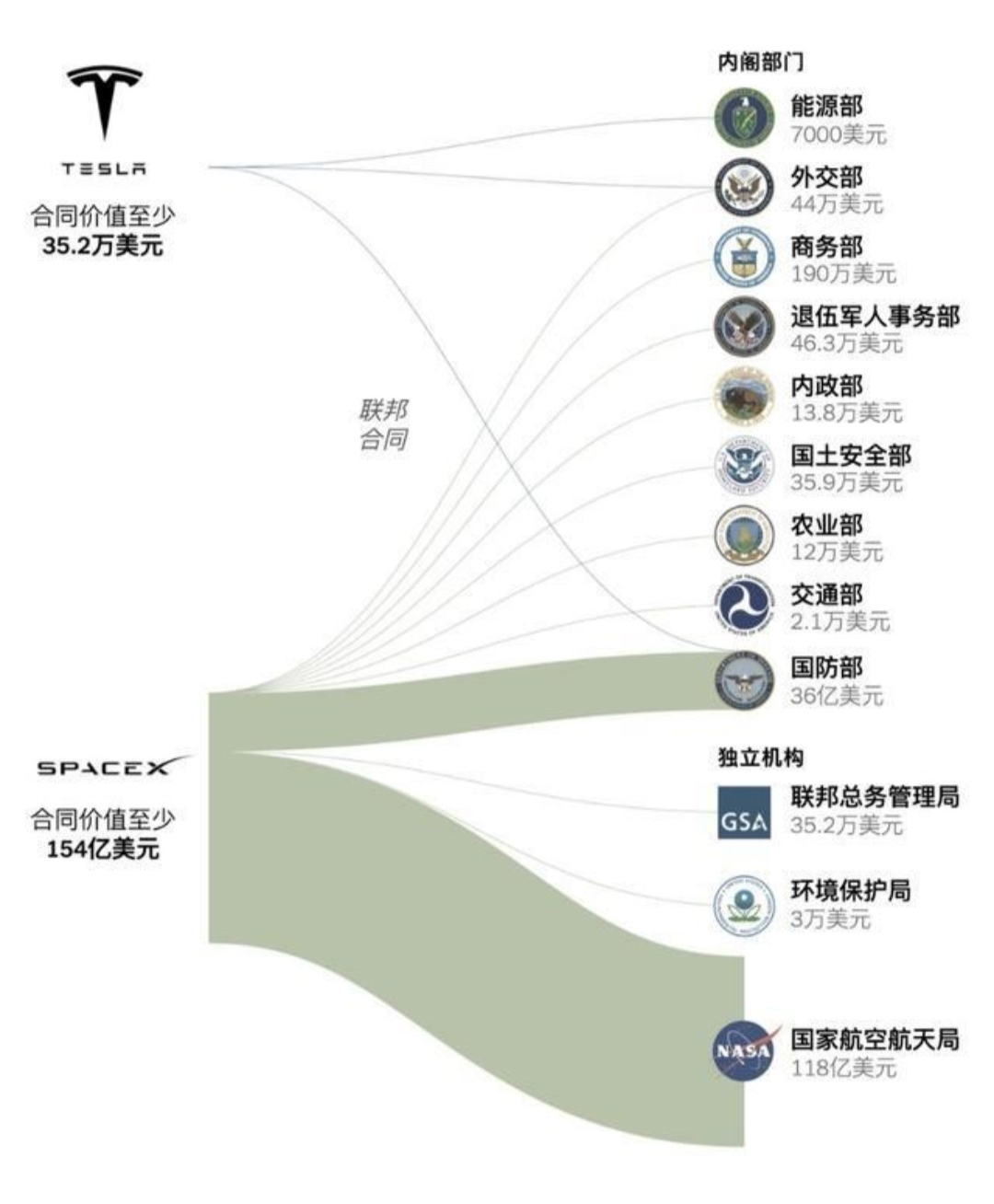
On November 19, Trump personally traveled to southern Texas to watch the launch of the SpaceX Starship rocket. This move highlighted his close relationship with SpaceX founder and billionaire Musk.
At the same time, as Musk has entered Trump’s core circle, it would be easy for him to create a situation where he is both a referee and an athlete in the US aerospace industry, which could lead to adjustments in US space policy and drastic changes in the industrial structure.
How will Trump's election affect the US aerospace industry? This question sparked discussion almost immediately after his victory, and the reason directly points to his relationship with Musk. In the aerospace field dominated by national power, Trump will play a key role as the head of government. On the other hand, SpaceX, founded by Musk, is the leader in the US space field, not only transporting cargo and astronauts, but also providing key services to NASA and the US military. After Trump takes office, he will reappoint the director of the National Aeronautics and Space Administration (NASA), review or adjust space policy, and so on.
Musk has entered Trump's inner circle, making it easy to create a situation where he is both the referee and the player, as this current CEO of SpaceX could become the most important advisor on U.S. space policy. More importantly, when two people who are both interested in space and have radical ideas come together, the adjustments to U.S. space policy could be very 'drastic'. On November 19, Trump was at SpaceX.
On November 19, Trump was at SpaceX.
Musk has already begun to benefit from successfully betting on Trump, bringing returns to him.
Evidently, in the ten days following the U.S. election on November 5, Tesla's stock price rose over 25%, a treatment not afforded to other large companies during the same period.
In the primary market, the Financial Times cited sources saying that SpaceX is preparing to initiate a share trading in December, with a valuation exceeding $250 billion, significantly up from a valuation of $210 billion in the first half of the year, which will continue to set new records for the valuations of U.S. private companies. Meanwhile, according to sources, Musk's AI company xAI has raised $5 billion, with a valuation of $45 billion, almost double its valuation from the first half of the year. Per Lekander, CEO of hedge fund Clean Energy Transition, commented on Tesla's stock performance, indicating that in the short term, Tesla's stock performance resembles a bet on how much Trump can help Musk in the future. As a backdrop, Musk's companies have intricate relationships with various regulatory agencies, involving business orders as well as numerous regulatory conflicts.
A New York Times survey shows that over the past decade, Tesla and SpaceX have received at least $15.4 billion in government contracts.
In the field of space, SpaceX effectively determines the timeline for NASA's launch missions, with most of the Department of Defense's satellites relying on SpaceX for launch. Just in the past year, 17 federal agencies awarded nearly 100 contracts to SpaceX, totaling about $3 billion. This complex network intuitively shows that Musk did not come to Trump as a neutral party, and although he does not currently hold a cabinet position, his close relationship with Trump still provides him with more influence.
During Trump's first term, he pushed to reduce regulation on businesses from almost day one, including in the space sector with the second space policy directive (SPD 2). In this regard, Musk needs to apply for hundreds of launch and test permits to the authorities each year, which has considerable benefits. Recently, the New York Times reported that Musk has suggested Trump hire core employees from SpaceX into his government, including the Department of Defense. Musk is quite familiar with this operation and has always been controversial. A series of actions seems to be a continuation of Musk's past style, continuously sparking controversy and achieving success. ArsTechnica space reporter Eric Berger said, 'In a vacuum environment, having someone like Musk helping the 21st-century U.S. space endeavor isn't necessarily a bad thing. But space is a vacuum, and Washington is not.' NASA and the entire government will feel the turbulence he brings.
Cost reduction and efficiency improvement
On November 12, Trump announced that Musk and Vivek Ramaswamy would serve as heads of the Department of Government Efficiency, abbreviated as DOGE. The aim is to dismantle the bureaucracy, reduce excessive regulations, cut wasteful expenditures, and restructure federal agencies, which Trump referred to as 'the Manhattan Project of our time', sounding very ambitious. One of the goals of cost reduction and efficiency improvement could be NASA itself. Regardless of its historical achievements, NASA is a massive bureaucratic institution. NASA engineer and Orion (Orion spacecraft) chief engineer Julie Kramer-White stated that the large engineering team is spread across nine different centers, including a team located in Europe, and even balancing time differences is a problem. As a result, the Orion spacecraft project has taken 20 years from inception to now, with costs overrunning by more than eight times, and R&D investment exceeding $20 billion.
In contrast, SpaceX's R&D and manufacturing costs for Starship are only about $5 billion. 'Now, NASA has expanded this model to multiple areas, covering satellite communications, lunar landers, and the commercialization of space stations. In addition to bureaucratic structures, the U.S. lunar Artemis program also faces adjustments.
Trump proposed the Artemis program during his first term to help the U.S. return to the moon and establish a permanent base, with the future goal of progressing to Mars.
This plan focuses on the moon, slowing down the exploration of Mars, and the project itself is progressing quite slowly. Musk has always looked down on this project, especially the core part of the Artemis program: the Space Launch System (SLS). He criticized this rocket as a symbol of government agency bloat, with R&D costs exceeding $20 billion, about ten times that of Starship, and it is a one-time use. The Trump administration may consider adjusting the Artemis program to instead use the Starship rocket to send humans to Mars. Additionally, the government could instruct NASA to integrate existing resources.
More uncertainty
For the past seventy years, space has mostly been a nonpartisan topic, and there may not be significant differences between the two parties, with more dissatisfaction stemming from Musk's gradual involvement in space policy. Some politicians and military personnel view over-reliance on SpaceX as both a political issue and a security issue. On social media, Musk has been targeted for anti-Semitic content, and globally, he has established relationships with leaders from multiple countries (mostly right-wing figures). In this context, especially for the U.S. government, whether Musk is reliable and controllable is a big question mark. Reports indicate that in 2022, Ukraine requested SpaceX to open Starlink positioning services over Crimea for military purposes but was rejected by Musk.
Musk himself already possesses the ability to bargain with the state. Meanwhile, they are also attempting to regain initiative and reduce dependence on a single supplier (mainly SpaceX). Global space cooperation also has uncertainties. In the Artemis program, NASA signed cooperation agreements with space agencies from Japan, the UK, Canada, and others under the name of joint lunar exploration. However, they may not be good friends of Trump and Musk.
Finally, there is the instability between Trump and Musk. Although Musk has invested real money and has become Trump's biggest supporter during the election period, they are currently very close, but both top businessmen have very fickle and decisive sides, and it is not hard to imagine a day when they might 'break up'. Various phenomena indicate that the complex cooperative relationship between the two is also full of uncertainties, but whether calm or explosive, U.S. space will usher in a new cycle. As stated in an ArsTechnica article: Folks, space policy is about to get pretty wild!
References
[1] https://www.ft.com/content/342e304b-4c09-4951-8bba-bc9a27ddb726[2] https://arstechnica.com/space/2024/11/space-policy-is-about-to-get-pretty-wild-yall/[3] https://cn.nytimes.com/technology/20241101/jeff-bezos-elon-musk-election/[4] https://cn.nytimes.com/usa/20241022/elon-musk-federal-agencies-contracts/





